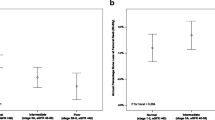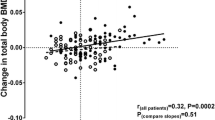Abstract
Bisphosphonate drugs for treating osteoporosis are excreted by the kidney. However, many of the major trials on efficacy and safety of the bisphophonates for treating osteoporosis excluded patients with significant renal compromise. Since both osteoporosis and renal insufficiency become more prevalent with age, it seems prudent for physicians to be aware of the prevalence of renal dysfunction in patients with osteoporosis who are candidates for treatment with bisphosphonates. Data on 13,831 men and women aged 20+ from the Third National Health and Nutrition Examination Survey, 1988–1994 (NHANES III) were used to study the occurrence of compromise in renal clearance function in men and women with osteopenia and osteoporosis. To estimate creatinine clearance (CCr), a measure of renal function, serum creatinine (sCr), weight and age were inserted into the Cockcoft-Gault (C-G) formula. The World Health Organization gender specific bone mineral density (BMD) cut-offs were used to define the populations with osteopenia and osteoporosis. For women ages 20–80+ with osteoporosis, the percent prevalence (95% CI) for mild to moderate compromise of CCr ≤60 ml/min is estimated to be 85% (79%, 91%) and for severe renal compromise of CCr <35 ml/min to be 24% (19%, 29%). In women with osteoporosis and severe compromise, the age specific prevalence is negligible through ages 50–59 and then rises steeply to 54% (46%, 62%) for ages 80+. Similarly, in women with osteopenia and severe renal compromise, the age specific prevalence is also negligible through ages 50–59 and then rises to 37% (28%, 45%) for ages 80+. Lower prevalence estimates hold for men with about 11% of men with osteoporosis having severe renal compromise as compared to 24% for women. These data suggest that there is a substantial prevalence of candidates for treatment of osteoporosis and osteopenia who have significant renal compromise but for whom there is a dearth of clinical trial data on the impact of treatment.


Similar content being viewed by others
References
Cummings SR, Black DM, Nevitt MC, Browner W, Cauley J, Ensrud K et al. (1993) Bone density at various sites for prediction of hip fractures. Lancet 341:72–75
Melton LJ III, Kan SH, Wahner HW, Riggs BL (1988) Lifetime fracture risk: an approach to hip fracture risk assessment based on bone mineral density and age. J Clin Epidemiol 41:985–994
Melton LJ III, Atkinson EJ, O'Fallon WM, Wahner HW, Riggs BL (1993) Long-term fracture prediction by bone mineral assessed at different skeletal sites. J Bone Miner Res 8:1227–1233
Ross PD, Wasnich RD, Davis JW (1990) Fracture prediction models for osteoporosis prevention. Bone 11:327–331
Looker AN, Johnston CC Jr, Wahner HW, Dunn WL, Calvo MS, Harris TB et al. (1995) Prevalence of low femoral bone density in older US women from NHANES III. J Bone Miner Res 10:796–802
Looker AN, Orwoll ES, Johnston CC Jr, Lindsay RL, Wahner HW, Dunn WL et al. (1997) Prevalence of low femoral bone density in older US adults from NHANES III. J Bone Miner Res 12:1761–1768
Jones CA, McQuillan GM, Kusek JW, Eberhardt MS, Herman WH, Coresh J et al. (1998) Serum creatinine levels in the US population: Third National Health and Nutrition Examination Survey. Am J Kid Dis 32:992–999
National Center for Health Statistics (1994) Plan and Operation of the Third National Health and Nutrition Examination Survey, 1988–1994, Vital Health Stat 1(32). DHHS Publication No. (PHS) 94-1308. NCHS, Hyattsville, Md.
Mohadjer, L. Montaquila J. Waksberg J, Bell B. James P, Flores-Cervantes I, Montes M (1996) National Health and Nutrition Examination Survey III. Weighting and estimation methodology. Westat Inc., Rockville, Md.
Cockcroft DW, Gault MH (1976) Prediction of creatinine clearance from serum creatinine. Nephron 16:31–41
Siris E (2000) Alendronate in the treatment of osteoporosis: a review of the clinical trials. J Women's Health Gend Based Med 9:599–606
Watts NB (1998) Treatment of osteoporosis with bisphosphonates. Endocrinol Metab Clin N Am 27:419–439
Black DM, Cummings SR, Karpf DB Cauley JA, Thompson DE, Nevitt MC et al. (1996) Randomized trial of effect of alendronate on risk of fracture in women with existing vertebral fractures. Lancet 348:1535–1541
Gertz BJ, Holland SD, Kline WF, Matuszewski BK, Porras, AG (1993) Clinical pharmacology of alendronate sodium. Osteoporos Int Suppl. 2:S13–16
Liberman UA, Weiss SR, Broll J, Minne HW, Quan H, Bell NH et al. (1995) Effects of oral alendronate on bone mineral density and the incidence of fractures in postmenopausal osteoporosis. N Engl J Med 333:1437–1443
Schnitzer T, Bone HG, Crepaldi G, Adami S, McClung M, Kiel D et al. (2000) Therapeutic equivalence of alendronate 70 mg once-weekly and alendronate 10 mg daily in the treatment of osteoporosis. Aging Clin Exp Res 12:1–12
Pols HA, Flesenberg D, Hanley DA, Stepan J, Munoz-Torres M, Wilkin TJ et al. (1999) Multinational, placebo-controlled trial of the effects of alendronate on bone density and fracture risk in postmenopausal women with low bone mass: results of the FOSIT Study. Fosamax International Trial Study Group. Osteoporos Int 9:461–468
McClung MR, Geusens P, Miller PD, Zippel H, Bensen WG, Roux C et al. (2001) Effect of risedronate on the risk of hip fracture in elderly women. N Engl J Med 344:333–340
Mitchell DY, St Peter JV, Pallone KA, Kelly SC, Russell DA, Nesbitt JD, Thompson GA, Powell JH (2000) Effects of renal function on risedronate pharmacokinetics after a single oral dose. Br J Clin Pharmacol 49:215–222
Yendt ER, Cohanim M, Jarzylo S, Jones G, Rosenberg G (1991) Bone mass is related to creatinine clearance in normal elderly women. J Bone Miner Res 6:1043–1050
Yendt ER, Cohanim M, Jarzylo S, Jones G, Rosenberg G (1993) Reduced creatinine clearance in primary osteoporosis in women. J Bone Miner Res 8:1045–1052
Acknowledgement
The authors of this manuscript gratefully acknowledge the financial support of this work from Procter and Gamble Pharmaceuticals, Inc.
Author information
Authors and Affiliations
Corresponding author
Rights and permissions
About this article
Cite this article
Klawansky, S., Komaroff, E., Cavanaugh, P.F. et al. Relationship between age, renal function and bone mineral density in the US population. Osteoporos Int 14, 570–576 (2003). https://doi.org/10.1007/s00198-003-1435-y
Received:
Accepted:
Published:
Issue Date:
DOI: https://doi.org/10.1007/s00198-003-1435-y




